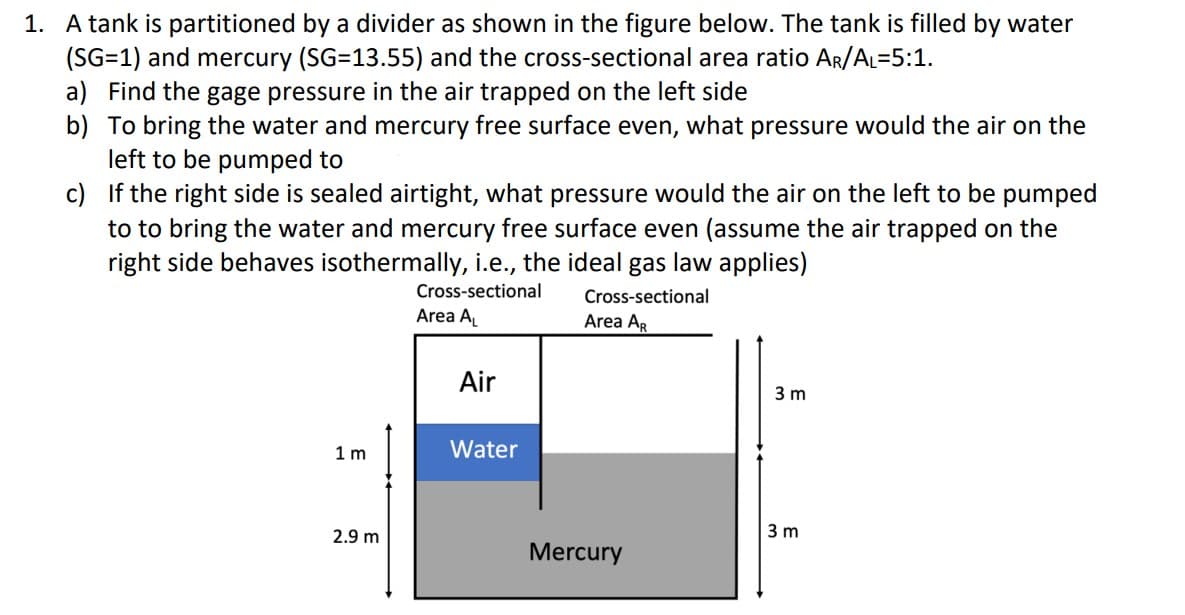A tank is partitioned by a divider as shown in the figure below. The tank is filled by water (SG=1) and mercury (SG=13.55) and the cross-sectional area ratio AR/AL=5:1. a) Find the gage pressure in the air trapped on the left side b) To bring the water and mercury free surface even, what pressure would the air on the left to be pumped to c) If the right side is sealed airtight, what pressure would the air on the left to be pumped to to bring the water and mercury free surface even (assume the air trapped on the right side behaves isothermally, i.e., the ideal gas law applies)
A tank is partitioned by a divider as shown in the figure below. The tank is filled by water (SG=1) and mercury (SG=13.55) and the cross-sectional area ratio AR/AL=5:1. a) Find the gage pressure in the air trapped on the left side b) To bring the water and mercury free surface even, what pressure would the air on the left to be pumped to c) If the right side is sealed airtight, what pressure would the air on the left to be pumped to to bring the water and mercury free surface even (assume the air trapped on the right side behaves isothermally, i.e., the ideal gas law applies)
Elements Of Electromagnetics
7th Edition
ISBN:9780190698614
Author:Sadiku, Matthew N. O.
Publisher:Sadiku, Matthew N. O.
ChapterMA: Math Assessment
Section: Chapter Questions
Problem 1.1MA
Related questions
Question
Please explain part b and c

Transcribed Image Text:1. A tank is partitioned by a divider as shown in the figure below. The tank is filled by water
(SG=1) and mercury (SG=13.55) and the cross-sectional area ratio AR/AL=5:1.
a) Find the gage pressure in the air trapped on the left side
b) To bring the water and mercury free surface even, what pressure would the air on the
left to be pumped to
c)
If the right side is sealed airtight, what pressure would the air on the left to be pumped
to to bring the water and mercury free surface even (assume the air trapped on the
right side behaves isothermally, i.e., the ideal gas law applies)
Cross-sectional
Area A₁
Cross-sectional
Area AR
1m
2.9 m
Air
Water
Mercury
3 m
3 m
Expert Solution
This question has been solved!
Explore an expertly crafted, step-by-step solution for a thorough understanding of key concepts.
Step by step
Solved in 4 steps

Knowledge Booster
Learn more about
Need a deep-dive on the concept behind this application? Look no further. Learn more about this topic, mechanical-engineering and related others by exploring similar questions and additional content below.Recommended textbooks for you

Elements Of Electromagnetics
Mechanical Engineering
ISBN:
9780190698614
Author:
Sadiku, Matthew N. O.
Publisher:
Oxford University Press

Mechanics of Materials (10th Edition)
Mechanical Engineering
ISBN:
9780134319650
Author:
Russell C. Hibbeler
Publisher:
PEARSON

Thermodynamics: An Engineering Approach
Mechanical Engineering
ISBN:
9781259822674
Author:
Yunus A. Cengel Dr., Michael A. Boles
Publisher:
McGraw-Hill Education

Elements Of Electromagnetics
Mechanical Engineering
ISBN:
9780190698614
Author:
Sadiku, Matthew N. O.
Publisher:
Oxford University Press

Mechanics of Materials (10th Edition)
Mechanical Engineering
ISBN:
9780134319650
Author:
Russell C. Hibbeler
Publisher:
PEARSON

Thermodynamics: An Engineering Approach
Mechanical Engineering
ISBN:
9781259822674
Author:
Yunus A. Cengel Dr., Michael A. Boles
Publisher:
McGraw-Hill Education

Control Systems Engineering
Mechanical Engineering
ISBN:
9781118170519
Author:
Norman S. Nise
Publisher:
WILEY

Mechanics of Materials (MindTap Course List)
Mechanical Engineering
ISBN:
9781337093347
Author:
Barry J. Goodno, James M. Gere
Publisher:
Cengage Learning

Engineering Mechanics: Statics
Mechanical Engineering
ISBN:
9781118807330
Author:
James L. Meriam, L. G. Kraige, J. N. Bolton
Publisher:
WILEY